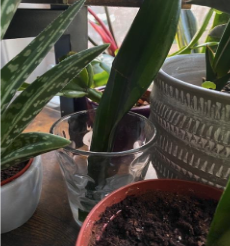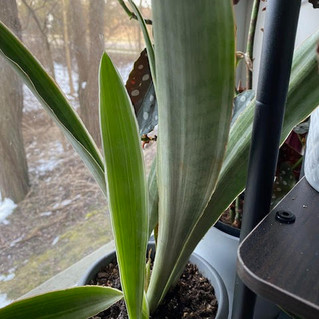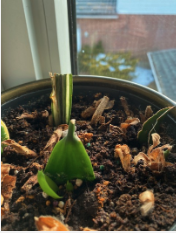How to take care of Sansevieria, also known as Snake Plants.
- Waterloo Gardeners
- May 15, 2024
- 4 min read
Updated: May 30, 2024

Rhonda, one of our members, is an avid collector of Sansevieria, commonly known as snake plant. She has years of expertise with, and passion for, the genus and she shared with us tips on how to keep these highly adaptable and low-maintenance houseplants happy and thriving.
Rhonda: I have had this snake plant in the corner of my living room for years. It just keeps growing (4 feet now), and every 5 years, I split it up a bit and give some away. The plant sits in a north, shady window where it gets a little water every couple of weeks, but is largely ignored. Maybe it was a little boring, but it was a lovely, easy plant that took care of a rather dim corner. Many people seem to have one hanging around, and many offices use them as area dividers, nicer to look at than a gray cubicle wall.
I did use this large Sansevieria Trifasciata for some propagation practice. If one of the leaves broke, I would cut it into 4-inch pieces, put some pieces in water, and plant some in soil with a bit of rooting compound. It took a few months, but they rooted and grew using both methods.
Varieties
Sansevieria plants offer a delightful array of options, with each variety showcasing unique colours, shapes, and patterns. From the vibrant hues of the 'Lauren' to the earthy tones of the 'Whitney, 'there's a Sansevieria for every taste.” Despite their individual preferences, all Sansevieria plants thrive in bright, indirect light and require infrequent watering, making them a versatile and low-maintenance choice for any indoor environment.
There is a whole range of colours and variations of the colours, as well as different shapes. At some point, I can see this primarily yellow one (Lauren), then a molted copper (coppertone), then a silver one (Sayuri) and then a dark green (Whitney) with light edges.
You can see more varieties here, including bird nests, flame, moonshine, and Laurentii.
Some of my favourites include, silver and white stripe (Bentel), and round fronds with a twisted stem giga spikey...and then my current two favourites, the Cleopatra (red edges) and the Variegated Boncel.
General care tips for different types of Sansevieria:
Soil: Use well-draining potting soil, ideally a mix designed for cacti and succulents.
Water: Allow the soil to dry out completely between waterings. In winter, reduce watering to once a month or less. DO NOT overwater
Light: Sansevierias prefer bright, indirect light but can tolerate lower light conditions.
Temperature: Keep your snake plants at average room temperature.
Potting: Choose a pot with a drainage hole to prevent water from accumulating at the bottom.
Each variety may have specific needs, so it's always a good idea to research your particular type of Sansevieria.
Propagating Snake Plants
Propagating snake plants is a straightforward process that can be done in several ways. Here are the most common methods:
Division: This is best for mature plants. Remove the plant from its pot and divide it into smaller sections, ensuring each has some roots attached. Replant the divisions in fresh potting soil. The sections (clumps, similar to a hosta) should be manageable.
Leaf Cuttings in Soil: Cut a healthy leaf near the base and plant the cut end into moist potting soil. Keep the soil lightly moist and wait for roots to develop.
Leaf Cuttings in Water: Place the cut end of a leaf into a jar of water. Change the water weekly and wait for roots to form before planting in the soil.
Rhizome Cuttings: Cut a piece of rhizome (the horizontal stem) with at least one leaf. Plant the rhizome cutting in the soil, ensuring the leaf is above the surface.
New growth can take a few weeks to a few months to show, so you need to be patient. One of the plants have babies, and the plants in the water are waiting for roots to appear.
Many aloe vera are similar in that they resemble snake plant varieties. The easy-to-see/feel difference between a snake plant and an aloe vera is that an aloe vera always has bumps around the edge, and a sansevieria has a smooth edge.

Sansevieria, or snake plants, are generally robust and resistant to pests and diseases. However, they can occasionally be affected by a few common issues:
Root Rot: Often caused by overwatering or poor drainage, root rot leads to yellowing and mushy leaves. To treat it, allow the soil to dry out between waterings and ensure good drainage.
Leaf Spot: This disease, resulting from fungal or bacterial infections, presents as brown or black spots on the leaves. Remove affected leaves and improve air circulation to manage this issue.
Mealybugs: These pests appear as small, white, cotton-like insects that feed on the plant’s sap, causing stunted growth and yellowing leaves. Treat with rubbing alcohol or insecticidal soap.
Scale Insects: They attach themselves to the stems and leaves, appearing as raised bumps or scales. They can be treated similarly to mealybugs.
Regular inspection and keeping your plants clean can help prevent these pests and diseases. If you notice any signs of distress, isolate the affected plant to prevent the spread to others and treat accordingly.
Now that you’ve learned a bit more about how easy it is to grow a snake plant, I hope that you’ll pick one up at your local plant sale and share in the joy of owning one.
Thank you for sharing your expertise with us, Rhonda!




























Comments